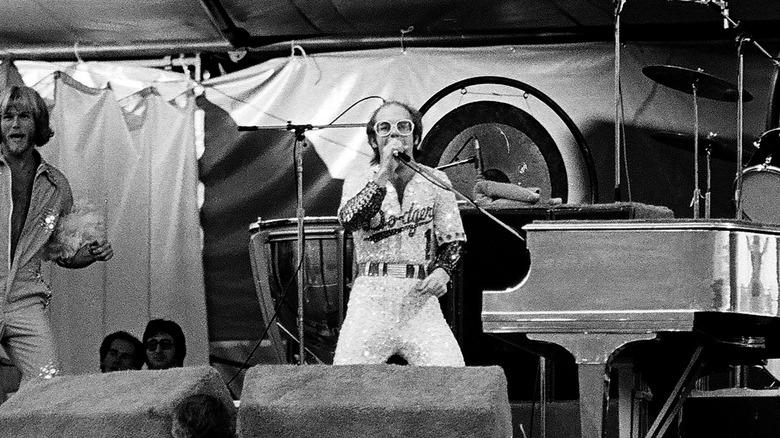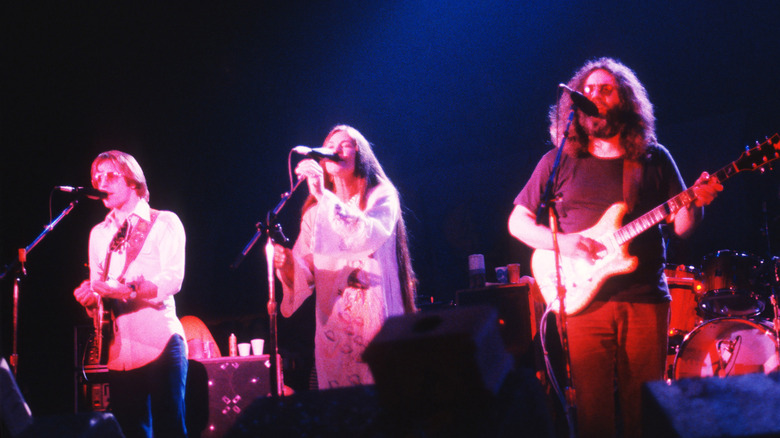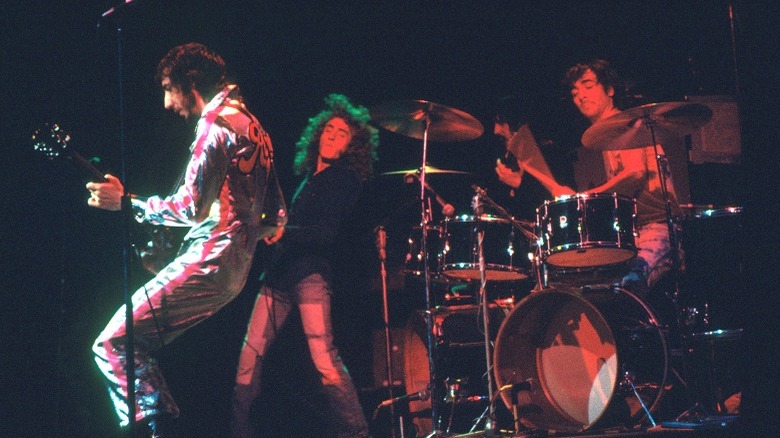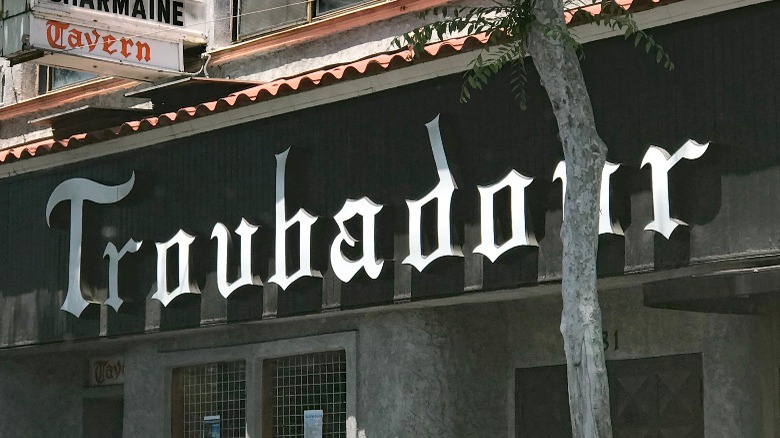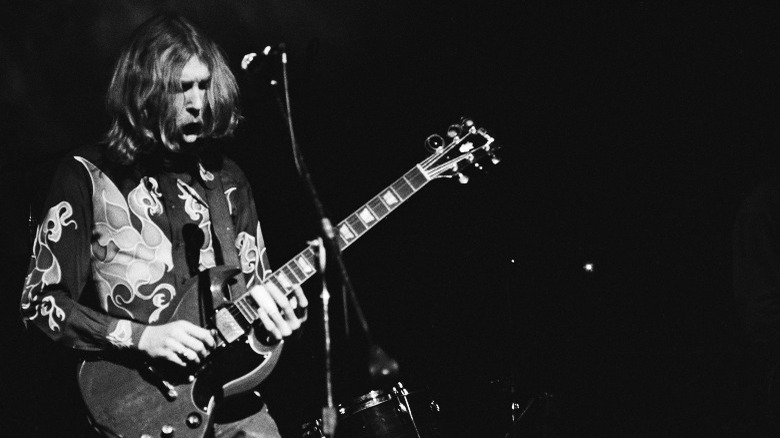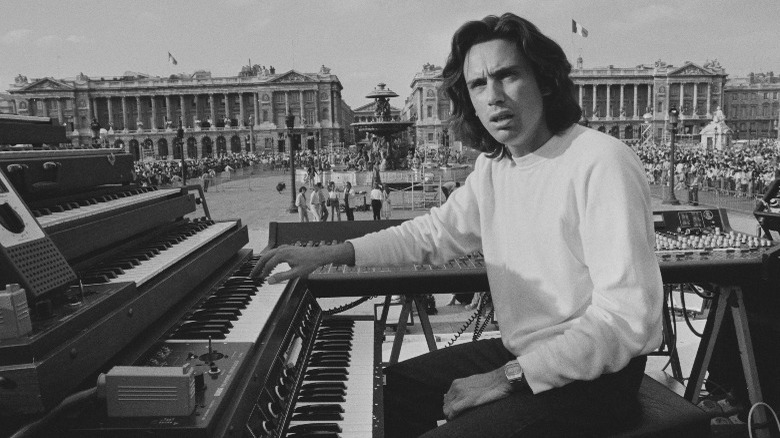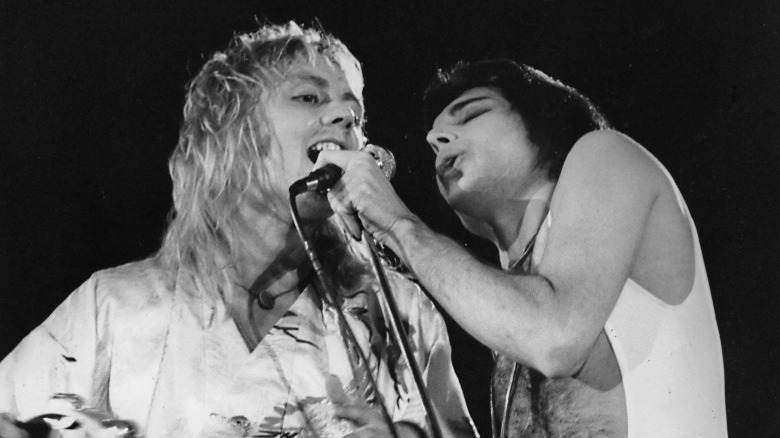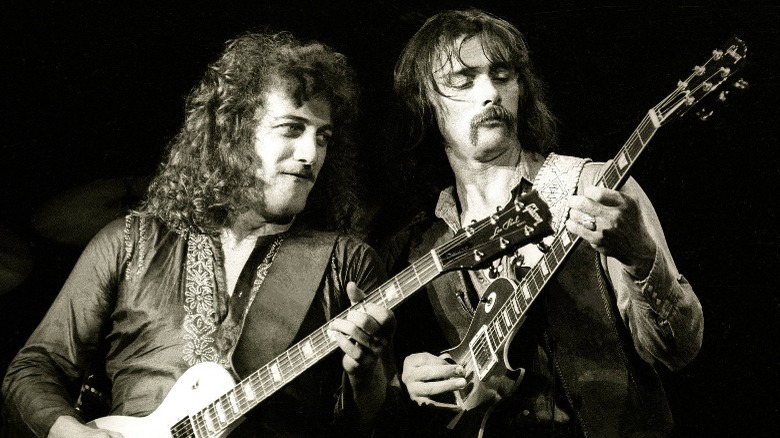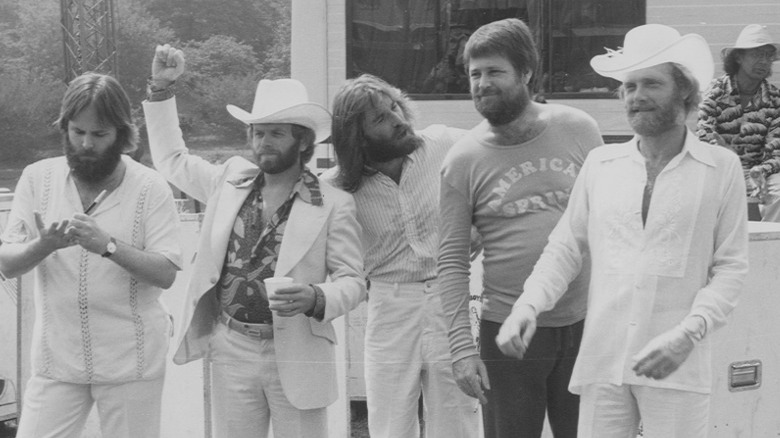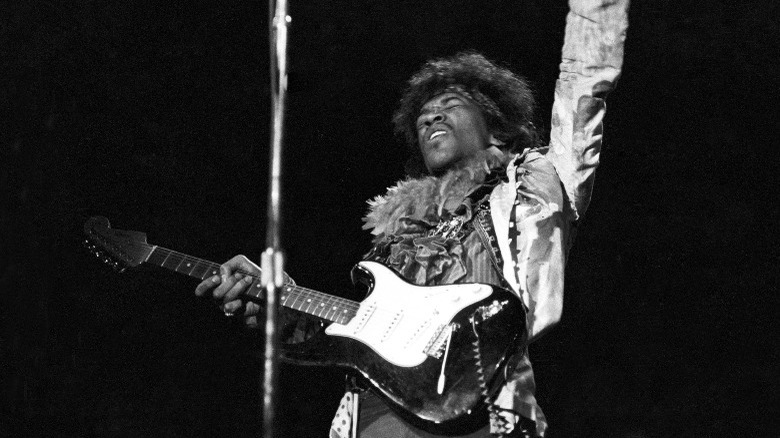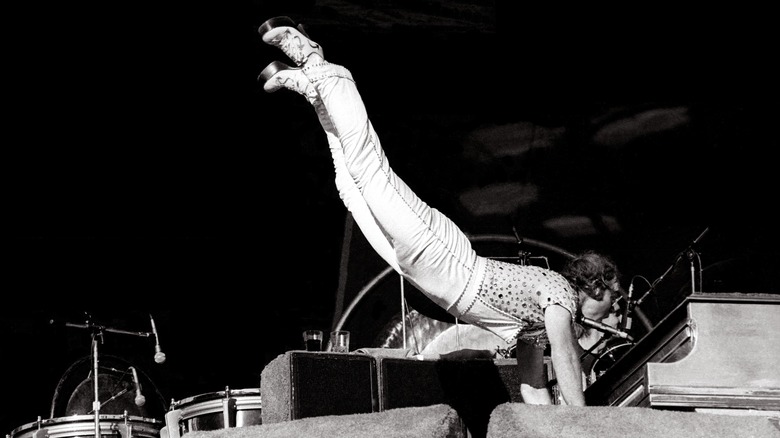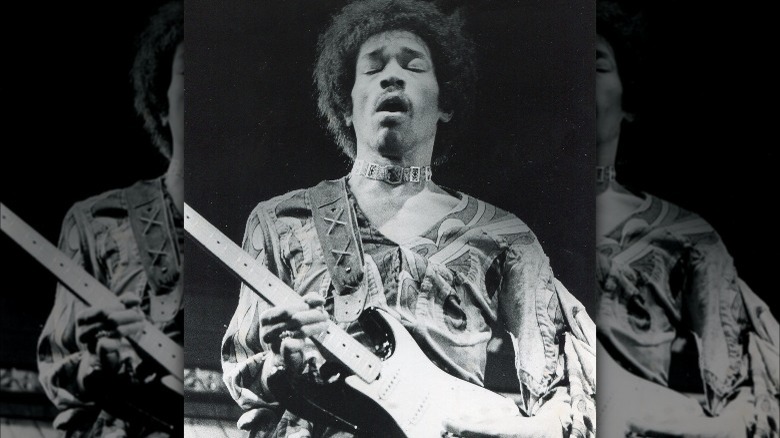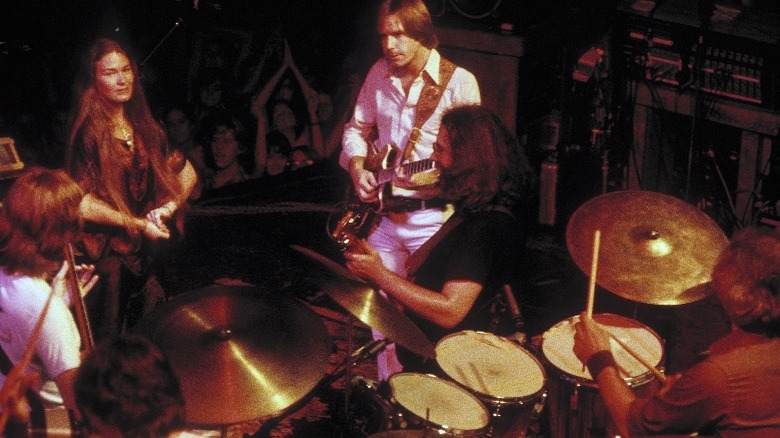The Biggest Concerts Of The 1970s
Looking back, some of the most memorable concerts in history took place in the 1970s. It was a very different music climate, as these were the days before electronic music and hip-hop dominated the charts and airwaves. Some of the most popular acts still had horn sections in them, and solo singers were largely backed by bands rather than beats. Musicians from the 1950s were still hanging on and delighting audiences, and many of the bands from Woodstock made the transition to the '70s, too.
As music popularity grew, so did the venues, and festivals were still all the rage in the '70s. Some of them, like the Isle of Wight or Summer Jam, had more than half a million attendees, showing that the spirit of Woodstock was not completely dead.
Some of the greatest concert films of all time came out of the '70s, and people still can't get enough of watching their favorite rockers from the era perform today — at least those who are still with us. From Jean-Michel Jarre to the Beach Boys, these were the biggest concerts of the 1970s.
The Grateful Dead's epic closing of Winterland
If ever there was a band that personified the 1970s, it was the Grateful Dead. They brought the decade in by playing a concert in Boston, and they closed it by playing one in Oakland, California. In between, they spent nearly every year (except 1975) actively touring, and they released an incredible 10 albums. They were based in San Francisco, and one of their favorite venues in the city was the famed Winterland Ballroom. However, after years of concerts and events, it was falling apart, to the point that legendary promoter Bill Graham — who ran the ballroom through his production company — decided it was time to close.
Graham chose the Grateful Dead to throw the last concert, which they did on New Year's Eve 1978. Instantly, there was an incredible demand for tickets, with people from as far away as Tokyo writing in to ask about attending the show. The entire concert was broadcast on both TV and the radio in the Bay Area.
To make the event extra special, there were some incredible guests, and the Grateful Dead's set had quite the beginning. Instead of your traditional countdown, Graham descended on the stage as "Father Time," transported on a "12-foot-long burning [cigarette] ember of marijuana." The Blues Brothers with Dan Aykroyd and John Belushi opened, and Bill Murray, future congressman Al Franken, and NBA star Bill Walton were also backstage or in attendance.
The Who plays at the University of Leeds
From The Band's legendary farewell captured in Martin Scorsese's "The Last Waltz," to Pink Floyd's epic concert at Pompeii, to "Frampton Comes Alive," the 1970s produced some of the greatest live albums and documentaries in history. One of the very first albums to start this trend was The Who's fabled concert at the University of Leeds in 1970. The Who were riding a massive wave of popularity leading up to Leeds in February, as they had just released the rock opera "Tommy" and were buoyed by their memorable performance at Woodstock the previous summer.
In an effort to release a live album harnessing the energy of their "Tommy" shows, the band booked concerts at both Hull and the University of Leeds in Britain. The Hull show was great, but the recordings were thought to be unusable because bassist John Entwistle could not be heard on some of the tracks. So, the band switched to recordings of the Leeds show, which turned out to be a fortuitous decision.
A critic from The New York Times at the time remarked that the show "caught on record, their un equaled [sic] ferocity and power." Today, many acknowledge it as the definitive live album by The Who, which is saying something considering their live catalog. The Who included several covers on the album, but they play them with such ferocity and tenacity you could easily mistake them for originals.
Elton John's career takes off at the Troubadour
It's hard now to remember a time when Elton John was not a huge rockstar. Born in 1947, John began his career in his native Britain in the late '60s. In 1970, he released his self-titled album, but being as John had never performed in America, the album did not have much success here. That all changed when he made his American debut that August in Los Angeles, California, playing at the legendary Troubadour.
He was only 23 years old and the Troubadour could only hold about 300 people, but these quickly became the things of legend. His record company, UNI Records, put up $10,000 for his U.S. tour and also invited a host of famous musicians to be at John's American debut. They booked him for six days at the club, where he would play a total of eight concerts, mesmerizing the audience with his unique brand of piano-based rock and roll. Some of the guests included Brian Wilson, Neil Diamond, Crosby, Stills, and Nash, Randy Newman, and Linda Ronstadt.
Though John was nervous at first and the Troubadour audience was surprised by his flamboyant costume, he ended up performing well. By the end of the week, the concerts were a major celebrity hangout and everyone wanted to be there. When John's first single, "Your Song," dropped that October, it saw immediate success.
The Allman Brothers rock the Fillmore East
Eventually released as a critically acclaimed double live album, the Allman Brothers shows at the Fillmore East in March 1971 are legendary today. The band had formed just a few years prior and released their first album in 1969. While they didn't have much commercial success at first, their live shows immediately drew crowds due to their virtuoso playing and psychedelic jamming. What the band really needed was an album that could harness the energy and excitement from their live performances.
Planning on recording for a live album, the band played as part of a ticket with opening act Elvin Bishop and headliner Johnny Winter for three consecutive nights from March 11–13. They had previously played the Fillmore East a few times starting in 1969, and were in the midst of a grueling touring schedule that saw them play as many as 300 concerts in 1970 alone.
Some of the top performances from the Fillmore East stand were a nearly 23-minute version of "Whipping Post" and a 19-minute version of "You Don't Love Me," the latter originally written by Willie Cobbs. The performances were so good that they put some of them on their next studio album, "Eat A Peach," including a version of "Mountain Jam" that lasted more than half an hour. Unfortunately, these would be some of the last shows to feature original guitarist Duane Allman, who would die a short time later, adding even more to the mystique of the Fillmore East run.
Jean-Michel Jarre plays to more than a million
For those familiar with Jean-Michel Jarre, it's probably little surprise that he played one of the biggest concerts of the 1970s. Jarre holds the Guinness Record for the largest paying rock concert by a solo artist, when more than three million fans saw him play in Moscow in the 1990s. Jarre got his start back in the mid-1970s, releasing his first album, "Les Granges Brulees," in 1973. Within a few years, he became known for his extensive concerts that attracted huge audiences.
On July 14, 1979, Jarre played the biggest concert of his career at the Place de la Concorde in Paris, France. It's estimated that between 1 and 1.5 million people saw Jarre that day, on what was the French holiday of Bastille Day. This was the first time that Jarre had performed by himself in an open-air setting, and he played his albums "Oxygene" and "Equinoxe." According to an interview Jarre gave in 2016 with Red Bull Music Academy, part of the reason so many people came out was due to the two nights of rehearsal before the show, which attracted crowds. The concert started at sunset, and they had to block off part of the square to get everything set up.
Queen at Hyde Park
Queen was one of the most prominent and well-known groups in rock history, and Hyde Park is one of the most famous historical places in London. So it only makes sense that at some point they would come into contact with each other. In the mid-1970s, Queen was just beginning their rise to mega-stardom. They had their first real hits in 1974 with the singles "Seven Seas of Rhye" and "Killer Queen," but in 1975 things changed forever when they released "A Night at the Opera." "Opera" had the famous anthem "Bohemian Rhapsody" on it, which was their first No. 1 hit and finally brought them to everyone's attention.
A year later, Queen played one of their most attended concerts ever, and it happened at Hyde Park in London. The date was September 18, 1976, and there were anywhere from 150–200,000 people in attendance. The show was put on for free by Queen, and it is still the largest in Hyde Park's illustrious history. The band opened with "Bohemian Rhapsody" before also playing classics "You're My Best Friend," "Brighton Rock," and "Stone Cold Crazy."
Summer Jam 1973
In the annals of great rock and roll festivals in New York, Summer Jam 1973 is surely one of the best. The concert featured three '70s heavyweights, The Band, the Grateful Dead, and the Allman Brothers, and took place at Watkins Glen near Seneca Lake. According to Dennis McNally in "A Long Strange Trip," the idea had been conceived the year prior, when the Dead played a show in Hartford, Connecticut, at the Dillon Stadium. During the concert, several members of the Allman Brothers — including guitarist Dickey Betts (pictured right) and bass player Berry Oakley — sat and played a couple of songs with the Dead, prompting the inception of Summer Jam.
The location was the Grand Prix racetrack, and they initially planned for a maximum of 150,000 fans. However, word about the concert soon spread, and in the end there is estimated to have been 600,000 people who came to Watkins Glen for the show. In preparation, organizers brought in 100,000 gallons of water, 500 cops, and three helicopters; tickets went for just $10. Both the Dead and the Allman Brothers made $110,000 on the concert, which would have been quite the payday in 1973. The events were complete with a parachutist (who died upon landing), numerous arrests, and of course, dozens of abandoned cars littering the highway leading up to Watkins Glen.
The Beach Boys at Central Park and Rhode Island
In the 1960s, the Beach Boys were one of the biggest draws in America. The combination of mellow vocal harmonies, up-tempo surf rock, and all-American attitude, made the Beach Boys the kings of the USA for a time. By the mid-1970s, their popularity had waned after a string of inconsistent releases, but they could still pull in quite the crowd when they needed to. In 1976, they released the album "15 Big Ones," and played shows again with visionary Brian Wilson for the first time since the mid-1960s.
Getting the chance to see Wilson again was exciting for many, and the next year on September 1, 1977, the Beach Boys played to 75,000-150,000 people at Central Park in New York City. As The New York Times reported the next day, it was part of the WNEW-FM radio station's annual summer celebration, and the Beach Boys filled in for Jefferson Starship, who were usually there. The crowd had fun and got involved in the music, and was largely made up of teenagers.
The next day, on September 2, 1977, the Beach Boys then played a concert at the Narragansett Race Track in Pawtucket, Rhode Island, to an estimated 40,000 people. It's thought to be the biggest concert in Rhode Island history, and there is now a street titled "Beach Boys Way" in the area as a tribute to the epic concert.
The Atlanta International Pop Festival
Fans of 1960s rock music have undoubtedly heard of such famous events as the Monterey International Pop Festival, the Denver Pop Festival, and, of course, Woodstock. Yet, while it was just as star-studded, the 1970 Atlanta International Pop Festival has not gotten nearly the same amount of attention. It was a repeat of the same concert from the year before, and featured some of the most popular performers of the day. The list even included the cast of "Hair" from Memphis State University, who were scheduled to close out the show.
The 1970 festival began on July 3 and ended in the very early hours of July 6. The Allman Brothers played on both the opening and closing nights, later releasing an album of the performance. Other musicians included Jimi Hendrix — who headlined — B.B. King, Johnny Winter, and Spirit. A young Col. Bruce Hampton also made an appearance, and an estimated 400,000 people showed up to watch the show.
It even resulted in at least one of the local Georgia bands signing a record deal. The concert was also significant because it was headlined by a Black performer at a time when racial tensions were incredibly high in the South, especially in Georgia under Governor Lester Maddox.
Elton John at Dodger Stadium, 1975
Five years after his epic welcome to America at the Troubadour in 1970, Elton John once again found himself in Los Angeles, this time selling out Dodger Stadium for two incredible nights. By now, John was a huge star, and 1975 was him in all his '70s glory. Coming off two No. 1 albums, when John took the stage on October 25 for the first show of his two-night stand, 55,000 screaming fans were waiting.
Wearing a glittery LA Dodgers uniform and at times wielding a baseball bat from atop his piano, John absolutely rocked Dodger Stadium for two consecutive nights, thrilling and delighting the 110,000 people who saw him. Potentially the most memorable moment of the weekend came during his performance of "Don't Let the Sun Go Down On Me," when the crowd pulled out their Zippo lighters and illuminated the pitch black of the stadium through an orange glow.
The concerts lasted 3 ½ hours each, and the first took place two days after John had been honored with a star on the Hollywood Walk of Fame. At one point, he was joined onstage by a live lion, and Joe Walsh was the opening act. For many, Dodger Stadium in 1975 was peak Elton John, and he certainly rocked the house.
Isle of Wight Festival, 1970
If ever there was a time to go to music festivals, it was the late '60s and early '70s. You could see legendary acts like Jimi Hendrix, The Who, and the Allman Brothers in their heydey, and rock and roll was still in its primal and raw state. And while the United States certainly had its fair share of great ones, like Woodstock or any of the half-dozen international pop festivals, across the pond in England they could also throw down a rock festival or two.
One of the biggest British rock festivals of all time took place in August 1970: the Isle of Wight Festival. This was the third year of the festival, which had started in 1968. It had grown from a modest 8,000 fans back then to reportedly more than 600,000 in 1970. Some of the acts included Miles Davis, Hendrix, The Who, the Moody Blues, Sly and the Family Stone, and many others.
In particular, the concert stands out as one of the final live recordings of Hendrix's career, as he would die less than a month later in September. Though it was said to have been marked with chaos, the festival was surprisingly well run for the amount of people, though there was copious amounts of sex, drugs, and rock and roll — which the local papers were more than happy to note.
California Jam I and II
They might not be very widely remembered or talked about today, but in the 1970s, California Jams I and II were some outrageously awesome concerts. Both of them were held at Ontario Motor Speedway in southern California, with the first one taking place in 1974 and the second four years later in 1978. The 1974 concert included Deep Purple; Emerson, Lake, and Palmer; Black Sabbath; Earth, Wind & Fire; and several others. In 1978, the list changed to Foreigner, Heart, Aerosmith, Ted Nugent, Santana, and more. Either way, you couldn't lose.
Both California Jams were well attended, with 200,000 coming to the first one and 300,000 to the second. The events were produced by ABC Entertainment, who also broadcast some of the performances. In true 1974 festival fashion, the highways were clogged with abandoned cars as concert-goers left their rides to hear the music. In 1974, the stages were built on a temporary railroad track, and fans were allowed to camp out overnight due to the chaos of 42,000+ cars trying to make their way out of the packed parking lot.
Raceway Park '77
It seems like whenever there was a massive rock concert being held in the 1960s and 1970s, the Grateful Dead always seemed to make an appearance. No different was their epic jaunt at Raceway Park in New Jersey in 1977. According to Billboard (via WorldRadioHistory.com), the concert sold 107,019 tickets, going for just $10–$12 each. In addition to the Dead, the Marshall Tucker Band and New Riders of the Purple Sage also performed, and it was said to have been New Jersey's biggest rock concert ever.
The show took place on September 3, and was special for the Dead for a number of reasons. It marked the return of drummer Mickey Hart following a car accident, and it was also the first time they played "Truckin'" — probably their biggest commercial hit — in two years. According to the Asbury Park Press, officials from an adjacent town sued to stop the Dead from showing up — fearing they would bring outlaw biker gangs with them — but a judge refused to stop it and the concert went off (mostly) without a hitch.
